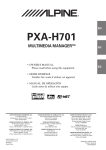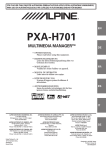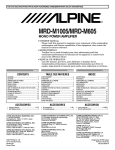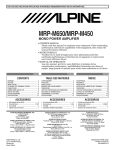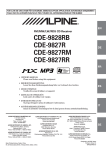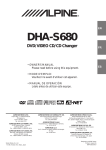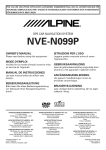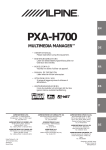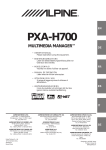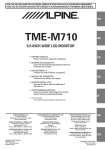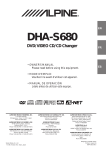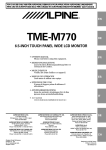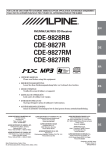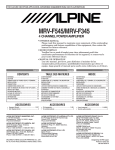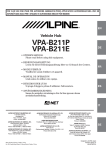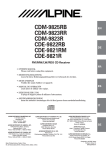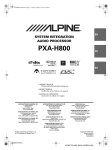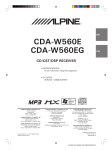Download Alpine PXA-H701 Car Stereo System User Manual
Transcript
FOR CAR USE ONLY/NUR FÜR AUTOMOBIL GEBRAUCH/POUR APPLICATION AUTOMOBILE UNIQUEMENT/ PARA USO EN AUTOMÓVILES/SOLO PER L'UTILIZZO IN AUTOMOBILE/ENDAST FÖR BILBRUK R EN PXA-H701 MULTIMEDIA MANAGER™ DE • OWNER'S MANUAL Please read before using this equipment. • BEDIENUNGSANLEITUNG Lesen Sie diese Bedienungsanleitung bitte vor Gebrauch des Gerätes. FR • MODE D'EMPLOI Veuillez lire avant d’utiliser cet appareil. • MANUAL DE OPERACIÓN Léalo antes de utilizar este equipo. • ISTRUZIONI PER L’USO Si prega di leggere prima di utilizzare il attrezzatura. ES • ANVÄNDARHANDLEDNING Innan du använder utrustningen bör du läsa igenom denna användarhandledning. ® IT ALPINE ELECTRONICS MARKETING, INC. 1-1-8 Nishi Gotanda, Shinagawa-ku, Tokyo 141-0031, Japan Phone 03-5496-8231 ALPINE ELECTRONICS OF AUSTRALIA PTY. LTD. 6-8 Fiveways Boulevarde Keysborough, Victoria 3173, Australia Phone 03-9769-0000 ALPINE ELECTRONICS OF AMERICA, INC. 19145 Gramercy Place, Torrance, California 90501, U.S.A. Phone 1-800-ALPINE-1 (1-800-257-4631) ALPINE ELECTRONICS GmbH Frankfurter Ring 117, 80807 München, Germany Phone 089-32 42 640 ALPINE ELECTRONICS OF CANADA, INC. 7300 Warden Ave., Suite 203, Markham, Ontario L3R 9Z6, Canada Phone 1-800-ALPINE-1 (1-800-257-4631) ALPINE ELECTRONICS OF U.K. LTD. Alpine House Fletchamstead Highway, Coventry CV4 9TW, U.K. Phone 0870-33 33 763 Kukje Printing Co., Ltd 127-2 Gamjeon-dong Sasang-gu Busan Korea ALPINE ELECTRONICS FRANCE S.A.R.L. (RCS PONTOISE B 338 101 280) 98, Rue de la Belle Etoile, Z.I. Paris Nord II, B.P. 50016, 95945 Roissy Charles de Gaulle Cedex, France Phone 01-48638989 ALPINE ITALIA S.p.A. Viale C. Colombo 8, 20090 Trezzano Sul Naviglio (MI), Italy Phone 02-484781 ALPINE ELECTRONICS DE ESPAÑA, S.A. Portal de Gamarra 36, Pabellón, 32 01013 Vitoria (Alava) - APDO 133, Spain Phone 945-283588 Designed by ALPINE Japan Printed in Korea (S) 68-00493Z09-A SE ENGLISH Before using The control unit for the PXA-H701 is sold separately. The operation method using this control unit (sold separately) is printed in this instruction manual. However, if you use head units such as the IVA-D300 series or the IVA-D900 series, you can also operate the PXA-H701 from these head units (Items such as AUTO TCR and navigation system voice guidance interruption settings can only be operated from the Control Unit). For more details on the head unit operation, see “External Audio Processor (Optional)” in the instruction manual for the head unit. FR Contents Using Dolby Surround Operating Instructions WARNING WARNING .................................................. 2 CAUTION ................................................... 2 PRECAUTIONS ......................................... 3 4 4 4 4 5 5 Installation and Connections Automatic Adjustments Performing time correction automatically (Automated Time Correction) ................................... 6 Settings/Adjustments Performing time correction manually (TCR)/Switching the phase .................................................................... 8 Bass Focus ..................................................................... 10 Graphic equalizer adjustments ...................................... 12 Parametric equalizer adjustments .................................. 13 X-OVER ........................................................................ 15 X-OVER adjustment ...................................................... 16 MX settings ................................................................... 18 BASS COMP. setting ..................................................... 19 20 21 22 22 23 24 25 25 ES Convenient Functions Navigation system voice guidance interruption (only when using the control unit sold separately) ........... Linear PCM setting ....................................................... Display settings ............................................................. MX mode setting (Ai-NET connection) ........................ Storing settings in the memory ...................................... Calling out stored values ............................................... Defeat mode ................................................................... Switching the display mode .......................................... Basic Operation Turning the power on and off .......................................... About indicators .............................................................. Operating the Rotary encoder .......................................... Setting the speakers ......................................................... Using with Ai-NET connections ..................................... Using with RCA-type or optical cable connections (non Ai-NET connections) (only when using the control unit sold separately) ...................................... Using the Pro Logic II mode ......................................... Adjustment procedure for Dolby Surround ................... Speaker setup ................................................................. Adjusting the speaker levels .......................................... Mixing bass sound to the rear channel .......................... Adjusting the acoustic image ......................................... Achieving powerful high volume sound ........................ Adjusting the DVD level ............................................... Warning ......................................................................... Caution .......................................................................... Precautions .................................................................... Accessories .................................................................... Installation ..................................................................... Basic Connections Diagram .......................................... Examples of system expansion ...................................... 26 26 27 27 28 28 28 29 30 30 31 32 33 36 37 Information Terminology .................................................................. 41 Others In case of difficulty ........................................................ 42 Specifications ................................................................ 43 1-EN DE IT SE WARNING WARNING This symbol means important instructions. Failure to heed them can result in serious injury or death. DO NOT OPERATE ANY FUNCTION THAT TAKES YOUR ATTENTION AWAY FROM SAFELY DRIVING YOUR VEHICLE. Any function that requires your prolonged attention should only be performed after coming to a complete stop. Always stop the vehicle in a safe location before performing these functions. Failure to do so may result in an accident. KEEP THE VOLUME AT A LEVEL WHERE YOU CAN STILL HEAR OUTSIDE NOISE WHILE DRIVING. Failure to do so may result in an accident. MINIMIZE DISPLAY VIEWING WHILE DRIVING. Viewing the display may distract the driver from looking ahead of the vehicle and cause an accident. DO NOT DISASSEMBLE OR ALTER. Doing so may result in an accident, fire or electric shock. USE THIS PRODUCT FOR MOBILE 12V APPLICATIONS. Use for other than its designed application may result in fire, electric shock or other injury. KEEP SMALL OBJECTS SUCH AS BATTERIES OUT OF THE REACH OF CHILDREN. Swallowing them may result in serious injury. If swallowed, consult a physician immediately. USE THE CORRECT AMPERE RATING WHEN REPLACING FUSES. Failure to do so may result in fire or electric shock. USE ONLY IN CARS WITH A 12 VOLT NEGATIVE GROUND. (Check with your dealer if you are not sure.) Failure to do so may result in fire, etc. DO NOT BLOCK VENTS OR RADIATOR PANELS. Doing so may cause heat to build up inside and may result in fire. 2-EN CAUTION This symbol means important instructions. Failure to heed them can result in injury or material property damage. HALT USE IMMEDIATELY IF A PROBLEM APPEARS. Failure to do so may cause personal injury or damage to the product. Return it to your authorized Alpine dealer or the nearest Alpine Service Center for repairing. PRECAUTIONS Temperature Be sure the temperature inside the vehicle is between +60°C (+140°F) and –10°C (+14°F) before turning your unit on. Installation Location Make sure the PXA-H701 will not be installed in a location subjected to: • Direct sun and heat • High humidity and water • Excessive dust • Excessive vibrations FR Maintenance If you have problems, do not attempt to repair the unit yourself. Return it to your Alpine dealer or the nearest Alpine Service Station for servicing. ES DE IT SE 3-EN Basic Operation Setting the speakers CHANNEL ENTER First make the speaker settings. Turn off speaker channels that are not connected. 1 SETUP Rotary encoder 2 PRO LOGIC II indicator Dolby Digital indicator DTS indicator 3 Press the SETUP button. The setup mode is set. Turn the Rotary encoder to select the “SPEAKER SELECT” mode, then press the ENTER button. Press the CHANNEL button to select the speaker, then press the ENTER button. Turning the power on and off This unit does not have a power switch. The head unit to which the unit is connected, controls its power. F1 (Front 1) Sub. W (Subwoofer) 4 NOTE When the power is turned ON for the first time, the SETUP mode is automatically activated. • PRO LOGIC II indicator Lights amber in the Dolby Surround decode mode • Dolby Digital indicator Lights amber in the Dolby Digital decode mode • DTS indicator Lights amber in the DTS decode mode Ct (Centre) Turn the Rotary encoder to set the speaker type ON or OFF, then press the ENTER button. Repeat steps 3 and 4 to set all unconnected speaker channels to “OFF”. NOTE Set to “Subwoofer” when a subwoofer is connected to the centre speaker output. Sub.W (Subwoofer) : ON/OFF * Operating the Rotary encoder 4-EN R (Rear) F1 (Front 1) : Tw (Tweeter)/Full (Full Range)/OFF F2 (Front 2) : Full (Full Range)/OFF R (Rear) : ON/OFF Ct (Centre) : Centre/Sub.W (Subwoofer)/OFF About indicators This unit uses the Rotary encoder when establishing settings or adjustments. When operating with the Rotary encoder, press the Rotary encoder and startup the Rotary encoder before the operation. F2 (Front 2) 5 When Full (Full Range) is selected in F1 (Front 1), the confirmation message of Tweeter presence will be displayed next. Turn the Rotary encoder and select YES/ NO, then press the ENTER button. Please set to protect the speakers. Press the SETUP button repeatedly to quit the setup mode. Using with Ai-NET connections When Ai-NET connections are used, the volume, subwoofer, balance and fader are adjusted from the head unit (they cannot be adjusted from the PXA-H701). However, BASS and TREB can not be adjusted from the head unit, so adjust them from PXA-H701. Adjusting the input level Using the analog, RCA-type connections, the PXA-H701’s input level must be preset from the head unit. Adjust the input level using a sound source with a high recording level (such as pop or rock music). 1 2 Using with RCA-type or optical cable connections (non Ai-NET connections) (only when using the control unit sold separately) 3 Switching the input The PXA-H701 is equipped with three sets of analog signal inputs and three sets of digital signal inputs. For further information about connections, see Page 36. 1 2 3 4 Turn the Rotary encoder to select the “INPUT SELECT” mode, then press the ENTER button. Turn the Rotary encoder to select the input mode, then press the ENTER button. Analog 1 Analog 2 Analog 3 Digital 3 Digital 2 Digital 1 Turn the Rotary encoder on the main unit counterclockwise and set the volume level to “0”. Gradually increase the volume of the head unit until “INPUT LEVEL OVER” appears in the display. Reduce the volume slightly from this position, until “INPUT LEVEL OVER” display just turns off. This completes the setting. Do not change the head unit volume level from this optimum setting. Use the PXA-H701, only, for changing the volume level. FR ES Adjusting the volume, balance, fader and subwoofer After determining the input level, adjust the volume, balance, fader and subwoofer from the PXA-H701. Be careful not to make these adjustments on the head unit. 1 Press the SETUP button repeatedly to quit the setup mode. NOTE Non Ai-NET connections Alpine products are equipped for a bus connection system called “Ai-NET” which can only be used for connections between Ai-NET products. The PXA-H701 is an Ai-NET product, but is designed to allow connections to other (non Ai-NET) products as well. Thus RCA-type and optical cable connections are also possible. Connections to non Ai-NET products are referred to as “non Ai-NET connections”. Turn on the head unit’s power. NOTE Switch to the spectrum analyzer display mode or the input channel display mode before adjusting the input level. (See page 29) Press the SETUP button. The setup mode is set. EN Press the ENTER button and select the mode to be adjusted. VOLUME 2 DE BALANCE Sub.W LEVEL IT FADER Turn the Rotary encoder within 5 seconds and adjust to the desired level. VOLUME BALANCE FADER Sub.W LEVEL : 0 ~ 35 : L15 ~ R15 : F15 ~ R15 : 0 ~ +15 SE NOTE When the subwoofer is set to “OFF”, the Sub.W LEVEL adjustment is ineffective. 5-EN Automatic Adjustments 3 AUTO TCR ENTER Connect the microphone. 1) Fasten the microphone included with control unit at the centre of the driver’s seat’s headrest facing upwards. To microphone input jack Microphone Belt, etc. Rotary encoder Performing time correction automatically (Automated Time Correction) Due to the particular conditions inside the vehicle, there is a major difference between the distances of the various speakers and the listening position. This function uses the included measurement microphone to automatically measure and analyse the distances between the speakers and the listening position and perform the optimum time correction. The AUTO TCR operation from the head unit may not be performed depending on the head unit combination. 1 2 2) Connect the microphone to the PXA-H701. Base unit To microphone input jack Microphone 4 Check that the defeat mode is off. (See page 28.) Prepare the vehicle. 1) Park the vehicle in a quiet place. 2) Close the vehicle’s doors and windows. 5 6 Set the vehicle’s engine key to the ACC position. • Vibrations could make it difficult to achieve the appropriate adjustment values, so turn the engine off. • Noise could make it impossible for automatic measurements to be made, so make sure the air conditioner, heater and all other devices are turned off. Press the AUTO TCR button. Turn the Rotary encoder, select the tweeter setting, then press the ENTER button. NO YES The count down starts. 7 Once the count down starts, get out of the vehicle and shut the doors within 10 seconds. AUT O TCR 10 sec . to 6-EN star t With the automatic adjustment function, the operation described below is performed. Adjustments are completed in about 10 seconds. Time correction. “END” is displayed for about 15 seconds and the automatic adjustment is completed. • EN If the microphone does not pick up the sound or the speakers are not working or are connected or wired improperly, the automatic adjustments are not performed and a error message is displayed. Check the various speakers then perform the automatic adjustments again. FR AUT O TCR ERROR 8 9 Check that the automatic adjustment has been completed (that “END” has been displayed for about 15 seconds), then get back into the vehicle and disconnect the microphone. ES To store, follow the procedure described at “Storing settings in the memory” (page 28). NOTES • Automatic measurements cannot be made unless the microphone is connected (error display). To perform time correction automatically, be sure to connect the included microphone first. • Before making automatic measurements, press the AUTO TCR button to cancel it. • No other operations can be performed while measurements are being made. • Measurements will differ according to the position in which the microphone is mounted. • Note that using for extended periods of time without turning on the engine may wear down the battery. • Automatic measurements cannot be made for the subwoofer. Make the subwoofer setting manually. Refer to “Performing time correction manually (TCR)/Switching the phase” (page 8). • When the speaker is set to the “OFF” mode, the TCR for that speaker cannot be adjusted. Refer to “Setting the speakers” (page 4). • After making the settings, we recommend storing them in the memory. For instructions, see page 28. DE IT SE 7-EN Settings/Adjustments TCR/PHASE CHANNEL ENTER • Concrete examples 1.Calculating the time correction value for the front left speaker on the diagram below. Conditions: Distance between farthest speaker and listening position: 2.25 m (88-3/4") Distance between front left speaker and listening position: 0.5 m (20") Calculation: L = 2.25 m (88-3/4") – 0.5 m (20") = 1.75 m (68-3/4") Compensation time = 1.75 ÷ 343 x 1000 = 5.1 (ms) Rotary encoder In other words, setting the time correction value for the front left speaker to 5.1 (ms) sets a virtual distance matching the distance to the farthest speaker. Performing time correction manually (TCR)/Switching the phase Because of the particular conditions inside the vehicle, there are major differences in the distances between the different speakers and the listening position. The proper time correction can be obtained using the automatic time correction function (“AUTO TCR”), but it is also possible to calculate the optimum correction values and eliminate the time error at the listening position yourself using this function. You can also use this function to switch the phase. When operating with head units such as the IVAD300 series, the adjustment is different depending on the head unit. 1 2 3 4 5.1ms 0.5m 2.25m The sound is uneven because the distance between the listening position and the different speakers is different. The difference in the distance between the front left and rear right speakers is 1.75 meters (68-3/4"). Check that the defeat mode is off. (See page 28.) Sit in the listening position (the driver’s seat, for example) and measure the distance (in meters) between your head and the various speakers. Calculate the difference in distance between the farthest speaker and the other speakers. L = (distance of farthest speaker) – (distance of other speakers) Divide the distances calculated for the different speakers by the speed of sound (343 m/s temperature 20°C). This value is the time correction value for the different speakers. 8-EN 5 Time correction eliminates the difference between the time required for the sound from the different speakers to reach the listening position. Setting the time correction of the front left speaker to 5.1 ms makes it possible to coordinate the distance from the listening position to the speaker. Press the TCR/PHASE button to set the time correction mode. 6 Press and hold the CHANNEL button for at least 2 seconds and select “L and R (LR)” or “L or R”. L and R (LR) Turn the Rotary encoder to switch the phase, then press the CHANNEL button. Press the ENTER button to return to step 8. L or R 0 (factory default) L and R (LR): Sets the same adjustment values for the left and right channels. L or R: Different adjustment values can be set for the left and right channels. 7 9 180 T CR / P H A S E L F 1 R R : RC DE L AY C 1 0 . 2 5ms PHAS E : 1 8 0 ° EN Press the CHANNEL button and select the desired channel, then press the ENTER button. When “L and R (LR)” is selected: Front 1 Front 2 Rear *1 Center TCR/PHASE button. Sub. W When “L or R” is selected: Front 1 L Front 1 R *3 *2 Sub. W Center Front 2 L Rear R 10 Repeat steps 7 to 9 to adjust other channels. 11 Once the adjustments are completed, press the FR Front 2 R Rear L NOTES • When the speaker is set to the “OFF” mode, the TCR for that speaker is ineffective. Refer to “Setting the speakers” (page 4). • After making the settings, we recommend storing them in the memory. For instructions, see page 28. *1 When centre is set to subwoofer, it is not displayed. *2 When centre is set to subwoofer, it becomes Sub.W(L). *3 When centre is set to subwoofer, it becomes Sub.W(R). 8 ES Turn the Rotary encoder to adjust the time correction value (0.00 ~ 20.00ms), then press the ENTER button. DE T CR / P H A S E L F 1 R R D E L A Y C: R C 1 0 . 2 5ms PHAS E : 1 8 0 ° IT * The difference in the sound when the defeat mode is turned off (adjusted time correction) and on (default value) can be checked as follows: 1) While in the adjustment mode, press and hold the TCR/PHASE button for at least 2 seconds. 2) Press the TCR/PHASE button to switch the defeat mode on and off and listen to the difference in the sound. 3) To quit, select the desired setting, then press the ENTER button. Note that if you press the ENTER button with the defeat mode turned on, the adjustments are reset to the defeat on status (the default values). SE 9-EN Settings/Adjustments 5 TCR/PHASE CHANNEL ENTER 6 7 B.C. Rotary encoder 8 Bass Focus The time difference between the front-rear/leftright speakers, can be adjusted a pair at a time. Audible time correction can be made from 0.05 ms to 20.00 ms in 401 steps (0 to 400). 1 2 3 4 Check that the defeat mode is off. (See page 28.) Press the TCR/PHASE button to select the time correction mode. Press the B.C. button to select the “BASS FOCUS” setting mode. Press the CHANNEL button to select the frontrear/left-right speaker. FL FR FL FR RL RR RL RR Front (left-right) speakers Left (front-rear) speakers FL FR FL FR RL RR RL RR Rear (left-right) speakers 10-EN Right (front-rear) speakers Turn the Rotary encoder to set the step of frontrear/left-right. Moreover, for setting another channel (speaker), repeat steps 4 and 5. After completing the setting, press the ENTER button to return to the time correction mode. Here, you can compare the sound of Defeat OFF (adjustment value) and Defeat ON (initial). For the operation method, refer to step 8 of “Performing time correction manually (TCR)/ Switching the phase” on page 9. Press the TCR/PHASE button to complete the setting. NOTE The setting made in Bass Focus is reflected in the time correction. Example of Steps 4 and 5 Setting 1.After entering corrections for the front (left and right) speakers in STEP 30, the time difference is 1.5 ms for both front-left and front-right speakers. 1.5ms 1.5ms 2. After entering corrections for the left (front and rear) speakers in STEP 30, the time difference becomes 3.0 ms* for the front left speaker, and 1.5 ms for the left rear speaker. * Because the time difference was already set to 1.5 ms for the front left speakers in STEP 1, the additional correction in STEP 30 makes the time difference of the front left speaker 3.0 ms. 3.0ms 1.5ms 1.5ms 1.5ms 1.5ms Time difference Table Number Time Number Time Number Time of Difference of Difference of Difference steps (ms) steps (ms) steps (ms) 0 0.00 34 1.70 68 3.40 1 0.05 35 1.75 69 3.45 2 0.10 36 1.80 70 3.50 3 0.15 37 1.85 71 3.55 4 0.20 38 1.90 72 3.60 5 0.25 39 1.95 73 3.65 6 0.30 40 2.00 74 3.70 7 0.35 41 2.05 75 3.75 8 0.40 42 2.10 76 3.80 9 0.45 43 2.15 77 3.85 10 0.50 44 2.20 78 3.90 11 0.55 45 2.25 79 3.95 12 0.60 46 2.30 80 4.00 13 0.65 47 2.35 81 4.05 14 0.70 48 2.40 82 4.10 15 0.75 49 2.45 83 4.15 16 0.80 50 2.50 84 4.20 17 0.85 51 2.55 85 4.25 18 0.90 52 2.60 86 4.30 19 0.95 53 2.65 87 4.35 20 1.00 54 2.70 88 4.40 21 1.05 55 2.75 89 4.45 22 1.10 56 2.80 90 4.50 23 1.15 57 2.85 91 4.55 24 1.20 58 2.90 92 4.60 25 1.25 59 2.95 93 4.65 26 1.30 60 3.00 94 4.70 27 1.35 61 3.05 95 4.75 28 1.40 62 3.10 96 4.80 29 1.45 63 3.15 97 4.85 30 1.50 64 3.20 98 4.90 31 1.55 65 3.25 99 4.95 32 1.60 66 3.30 33 1.65 67 3.35 100–399 5.00–19.95 400 20.00 EN FR ES DE IT SE 11-EN Settings/Adjustments G.EQ *1 When centre is set to subwoofer, it is not displayed. *2 When centre is set to subwoofer, it becomes Sub.W(L). *3 When centre is set to subwoofer, it becomes Sub.W(R). CHANNEL ENTER 5 Turn the Rotary encoder to select the frequency, then press the ENTER button. Adjustable frequencies Front/Rear/Centre: 20Hz~20kHz (1/3 octave step) Sub.W: 20Hz~160Hz (1/3 octave step) P.EQ Rotary encoder 6 Graphic equalizer adjustments Turn the Rotary encoder to adjust the level (± 9 dB in steps of 1 dB), then press the ENTER button. 3 1 –G . EQ F r o n t The graphic equalizer allows you to modify the sound using 31 bands each for the front (left and right), rear (left and right) and centre speakers. An additional 10 bands are available for the subwoofer. This allows you to customize the sound to suit your taste. 1 2 3 1 2 . 5 kHz 7 8 Check that the defeat mode is off. (See page 28.) Press and hold the CHANNEL button for at least 2 seconds and select “L and R (LR)” or “L or R”. L or R (factory default) L and R (LR): Sets the same adjustment values for the left and right channels. L or R: Different adjustment values can be set for the left and right channels. 4 Press the CHANNEL button to select the desired channel, then press the ENTER button. When “L and R (LR)” is selected: *1 Front Rear Center Sub. W When “L or R” is selected: Front L 12-EN Front R Rear L *3 *2 Sub. W Center Rear R –9 dB Repeat steps 5 and 6 to adjust other frequencies. To adjust other channels, press the CHANNEL button to return to step 4. * The difference in the sound when the defeat mode is turned off (adjusted graphic equalizer settings) and on (default values) can be checked as follows: 1) While in the adjustment mode, press and hold the G.EQ button for at least 2 seconds. 2) Press the G.EQ button to switch the defeat mode on and off and listen to the difference in the sound. 3) To quit, select the desired setting, then press the ENTER button. Note that if you press the ENTER button with the defeat mode turned on, the adjustments are reset to the defeat on status (the default values). Press the G.EQ button to set the graphic equalizer mode. L and R (LR) L 9 Once the adjustments are completed, press the G.EQ button. NOTES • When the speaker is set to the “OFF” mode, the graphic equalizer for that speaker is ineffective. Refer to “Setting the speakers” (page 4). • Check the playable frequency ranges of the connected speakers before making the equalizer adjustments. If the speaker’s playable frequency range is 55 Hz to 30 kHz, for example, adjusting the 40 Hz or 20 Hz band has no effect. Additionally, you may overload and damage the speakers. • After making the settings, we recommend storing them in the memory. For instructions, see page 28. • When graphic EQ is adjusted, the adjustment for parametric EQ becomes ineffective. Parametric equalizer adjustments 6 The frequency bands of the graphic equalizer are fixed. This makes it very difficult to correct for undesired peaks and dips at specific frequencies. The parametric equalizer’s centre frequency can be tuned these specific frequencies. Then, the bandwidth (Q) and level are fine-tuned, independently, to make the necessary corrections. The parametric equalizer function is an advanced tool for serious audiophiles. 1 2 3 P . EQPF r o n t L BAND : 4 Fc : 3 . 15 kHz Q :2 L v : +7 dB 7 Check that the defeat mode is off. (see page 28.) Press the P.EQ button to set the parametric equalizer mode. Press and hold the CHANNEL button for at least 2 seconds and select “L and R (LR)” or “L or R”. L and R (LR) 4 EN Turn the Rotary encoder to adjust the band width (Q), then press the ENTER button. The band width can be adjusted in 6 steps of 0.5/1/2/3/4/5. P . EQPF r o n t L BAND : 4 Fc : 3 . 15 kHz Q :2 L v : +7dB L or R (factory default) L and R (LR): Sets the same adjustment values for the left and right channels. L or R: Different adjustment values can be set for the left and right channels. Turn the Rotary encoder to select the frequency, then press the ENTER button. For the adjustable frequencies, see page 43. 8 ES Turn the Rotary encoder to adjust the level (±9 dB in steps of 1 dB), then press the ENTER button. Press the CHANNEL button to select the desired channel, then press the ENTER button. When “L and R (LR)” is selected: *1 Front Rear Center Sub. W When “L or R” is selected: Front L Front R Rear L *3 *2 Sub. W Center DE P . EQ F r o n t L BAND : 4 Fc : 3 . 15 kHz Q :2 L v : +7 dB Rear R IT *1 When centre is set to subwoofer, it is not displayed. *2 When centre is set to subwoofer, it becomes Sub.W(L). *3 When centre is set to subwoofer, it becomes Sub.W(R). 5 FR Turn the Rotary encoder to select the band, then press the ENTER button. SE Adjustable bands Front/Rear/Centre : 5 bands Sub.W : 2 bands P . EQPF r o n t L BAND : 4 Fc : 3 . 15 kHz Q :2 L v : +7dB 13-EN Settings/Adjustments CHANNEL ENTER P.EQ 9 Repeat steps 5 to 8 to adjust other bands. 10 To adjust other channels, press the CHANNEL button to return to step 4. * To compare the factory default settings (DEFEAT ON) with your newly adjusted parametric equalizer settings (DEFEAT OFF), do the following: 1) While in the adjustment mode, press and hold the P.EQ button for at least 2 seconds. 2) Press the P.EQ button to switch the defeat mode on and off and listen to the difference in the sound. 3) To quit, select the desired setting, then press the ENTER button. Note that if you press the ENTER button with the defeat mode turned on, the adjustments are reset to the defeat on status (the default values). 11 Once the adjustments are completed, press the P.EQ button. 14-EN NOTES • When the speaker is set to the “OFF” mode, the parametric equalizer for that speaker is ineffective. Refer to “Setting the speakers” (page 4). • It is not possible to adjust the frequencies of adjacent bands within 7 steps. • Check the playable frequency ranges of the connected speakers before making the equalizer adjustments. If the speaker's playable frequency range is 55 Hz to 30 kHz, for example, adjusting the 40 Hz or 20 Hz band has no effect. Additionally, you may overload and damage the speakers. • After making the settings, we recommend storing them in the memory. For instructions, see page 28. • When parametric EQ is adjusted, the adjustment for graphic EQ becomes ineffective. X-OVER Signals with these frequencies output The PXA-H701 is equipped with an active crossover allowing the frequency bands to be split before amplification. Because of this, there is no need for a passive network between the speakers and amplifiers. This makes the amplifiers fully independent, eliminating the problem of interference. This also makes it possible to achieve the optimum acoustic space by dividing the playback frequencies in a way suited to the speaker’s response. This adjustment requires sufficient knowledge and experience. If you have problems, we suggest you have the adjustment made by your store authorized of Alpine dealer. Adjust the high pass filter (H.P.F.) and low pass filter (L.P.F.) and set the slope (filter response attenuation slope) for the different bands. Make the adjustments according to the playable frequency ranges and frequency responses of the connected speakers. Cutoff frequency adjustment range (1/6 octave steps) H.P.F. L.P.F. Slope adjustment H.P.F. 20Hz The H.P.F. setting cannot be the same as or exceed the L.P.F. setting for that channel. • • • • • • 6/12/18/ 24/30dB/ Filter OFF • 1kHz – 18kHz Front 1 (Front speaker 1) Select FULL RANGE 20Hz – 18kHz 22Hz – 20kHz 6/12/18/ 24/30dB/ Filter OFF 6/12/18/ 24/30dB/ Filter OFF Front 2 (Front speaker 2) 20Hz – 18kHz 22Hz – 20kHz 6/12/18/ 24/30dB/ Filter OFF 6/12/18/ 24/30dB/ Filter OFF Rear (Rear speaker) 20Hz – 18kHz 22Hz – 20kHz 6/12/18/ 24/30dB/ Filter OFF 6/12/18/ 24/30dB/ Filter OFF Center* (Centre speaker) 20Hz – 18kHz 22Hz – 20kHz 6/12/18/ 24/30dB/ Filter OFF 6/12/18/ 24/30dB/ Filter OFF Sub.W (Subwoofer) 20Hz – 180Hz 22Hz – 200Hz 6/12/18/ 24/30dB/ Filter OFF 6/12/18/ 24/30dB EN 10kHz H.P.F. cutoff frequency L.P.F. cutoff frequency L.P.F. Front 1 (Front speaker 1) Select TWEETER 1.1kHz – 6/12/18/ 20kHz 24/30dB Slope OFF Slope adjustment • The crossover network is a filter that divides specific frequency bands. The high pass filter is a filter that cuts frequencies below a certain frequency (bass frequencies) and lets through treble frequencies. The low pass filter is a filter that cuts frequencies above a certain frequency (treble frequencies) and lets through bass frequencies. The slope is a value expressing the attenuation of the signal in decibels when the frequency is increased or decreased by one octave. The higher the slope value, the steeper the slope. If the slope is set to “OFF”, the signal does not pass through the filter, so there is no effect. In order to protect the speakers, if Tweeter is selected in Front 1, there is no filter OFF (slope OFF) setting for H.P.F. For the same reason, the subwoofer low pass filter cannot be turned off (the slope cannot be set to “OFF”.) Tweeters may be damaged if low frequency signals are input to them. FR ES DE IT * If centre is set as subwoofer, the adjustment range changes to the range of subwoofer. SE 15-EN Settings/Adjustments *1 When centre is set to subwoofer, it is not displayed. *2 When centre is set to subwoofer, it becomes Sub.W(L). *3 When centre is set to subwoofer, it becomes Sub.W(R). X-OVER CHANNEL ENTER 5 Rotary encoder X – OVE PR F r o n t HP f c : 3 5 0 HP s l o p e : 1 2 LPf c : 1 . 8k LPs I op e : 6 X-OVER adjustment This section describes the procedure for making the X-OVER adjustment. Before performing this procedure, see “X-OVER” on page 15. The SLOPE to FLAT operation from the head unit may not be performed depending on the head unit combination. 1 2 3 6 Check that the defeat mode is off. (See page 28.) 2 1/2 Turn the Rotary encoder to adjust the H.P.F. slope, then press the ENTER button. To set filter off (slope off), press and hold the XOVER button for at least 2 seconds. X – OVE PR F r o n t HP f c : 3 5 0 HP s l o p e : 1 8 LPf c : 1 . 8k LPs I op e : 6 2 1/2 Press the X-OVER button to set the X-OVER adjustment mode. Press and hold the CHANNEL button for at least 2 seconds and select “L and R (LR)” or “L or R”. L and R (LR) 7 8 L or R (factory default) L and R (LR): Sets the same adjustment values for the left and right channels. L or R: Different adjustment values can be set for the left and right channels. 4 Turn the Rotary encoder to adjust the H.P.F. cutoff frequency, then press the ENTER button. The adjustable bands differ according to the channel (speaker). Press the CHANNEL button to select the desired channel, then press the ENTER button. Next, make the adjust for the L.P.F. in the same way as in steps 5 and 6. Turn the Rotary encoder to adjust the level, then press the CHANNEL button. Press the ENTER button to return to step 5. The level can be adjusted between –12 and 0. X – OVE PR F r o n t Leve l : – 4 dB 2 2/2 When “L and R (LR)” is selected: Front 1 Front 2 Rear *1 Center Sub. W When “L or R” is selected: Front 1 L 16-EN Front 1 R *3 *2 Sub. W Center Front 2 L Rear R 9 Repeat steps 4 to 8 to adjust other channels. 10 Once the adjustments are completed, press the X-OVER button. Front 2 R Rear L Hint for adjusting the subwoofer • If the subwoofer is installed on the rear deck, setting a gentle L.P.F. slope (for example 6 dB/ oct.) makes the sound localization more to the rear. This can also affect the acoustic localization of the front. EN Hints for adjusting the high range • Depending on the speaker, inputting low frequency component signals (about 2 kHz or less) with the H.P.F. adjustment could result in distortion. If so, set a steep slope (for example 30 dB/oct.). When doing so, adjust so that the mid and high range sounds do not separate. • Normally use with the L.P.F. off. If the high range is too strong, we recommend adjusting for a gentle slope. FR Hint for adjusting the low range • When a subwoofer is connected and you are using a speaker with a low range of under 10 or 12 cm (3-15/16” or 4-3/4”), setting the low range H.P.F. to “OFF” can result in distortion when low frequency components are input. If so, set the H.P.F. slope to a value suited for the speaker’s frequency response. ES NOTES • In order to protect the speakers, if Tweeter is selected in Front 1, there is no filter OFF (slope OFF) setting for H.P.F. For the same reason, the subwoofer low pass filter cannot be turned off (the slope cannot be set to “OFF”.) • When the speaker is set to the “OFF” mode, the XOVER for that speaker is ineffective. Refer to “Setting the speakers” (page 4). • Check the playback frequencies of the connected speakers before adjusting. • After making the settings, we recommend storing them in the memory. For instructions, see page 28. DE IT SE 17-EN Settings/Adjustments FM: MX1 to 3 and OFF The medium to high frequencies become more clear, and produces well balanced sound in all the bands. CD: MX1 to 3 and OFF CD mode processes a large quantity of data. This data is used to reproduce the sound cleanly by making use of the data quantity. MP3/DAB: MX1 to 3 and OFF This corrects information that was omitted at the time of compression. This reproduces a well-balanced sound close to the original. DVD/Video CD: MOVIE MX 1~2, MUSIC, OFF MOVIE MX 1~2: The dialogues of movies are played with greater clarity. MUSIC: Discs containing music clips are played with a more dynamic sound. AUX: MP3, MUSIC, MOVIE, OFF Choose the MX mode (MP3, MUSIC, or MOVIE) that corresponds to the media connected. ENTER B.C. MX Rotary encoder MX settings MX (Media Xpander) makes vocals or instruments sound distinct regardless of the music source. The radio, CD, and MP3, will be able to reproduce the music clearly even in cars with a lot of road noise. 1 When “Auto” has been set as the MX mode setting (see page 27) while using the PXAH701 in combination with an Ai-NET head unit equipped with an automatic MX mode selection function (IVA-D300 series, etc.). In this case, the MX mode is selected automatically according to the music source on the head unit. The MX mode can be set from the PXA-H701 using the operation described below. 1 2 3 Press the MX button to set the MX setting mode. In case of “MX OFF”, press and hold the MX button for at least 2 seconds to turn the MX mode on. Turn the Rotary encoder to select the desired mode, then press the ENTER button. • When “OFF” is selected, the MX effect is turned off. • The level for the currently selected music source (radio, CD, etc.) can be adjusted. 18-EN 4 Once the settings are completed, press the MX button. NOTES • Operations cannot be performed when the defeat mode (page 28) is on. • Each music source, such as radio, CD, and MP3 can have its own MX setting. • If “MX OFF” is set in step 2, the MX mode is set to off for all music sources. 2 When combining non Ai-Net head unit products When combining Ai-Net head unit products without MX interlocking function When combining Ai-Net head unit products (IVA-D300 series, etc.) with MX interlocking function considering that “MX mode setting” (page 27) is set to “Manual”. In these cases, the PXA-H701 is not interlocked with the head unit, therefore it is necessary to set the MX from the PXA-H701 with the operations below. 1 2 Press the MX button to set the MX setting mode. In case of “MX OFF”, press and hold the MX button for at least 2 seconds to turn the MX mode on. 3 4 Turn the Rotary encoder to select the source (media) you want to set, then press the ENTER button. Turn the Rotary encoder to select the desired mode, then press the ENTER button. For further information about setting mode, see step 3 of 1 (page 18). EN NOTE This function is equipped to work anywhere in the world, and it is possible to set to “XM”. This mode is a specification developed for use abroad, but like “MP3/ DAB”, can have the same effect as “MX”. If set to “MD”, it also has the same effect as “MP3/DAB”. 5 6 To set other sources (media), press the MX button and return to step 3. FR Once the settings are completed, press the MX button repeatedly. NOTES • Operations cannot be performed when the defeat mode (page 28) is on. • The source (media), such as radio, CD, and MP3 can be set. • “MX OFF” can be set in step 2. ES BASS COMP. setting The sound of the low frequencies can be adjusted to suit your tastes. DE 1 2 3 4 5 Check that the defeat mode is off. (See page 28.) Press the B.C. button to set the “BASS COMP.” setting mode. In case of “BASS COMP. OFF”, press and hold the B.C. button for at least 2 seconds to turn the BASS COMP. mode on. IT Turn the Rotary encoder to select the desired mode, then press the ENTER button. As the bass level increases in order of BASS COMP. 1, BASS COMP. 2, BASS COMP. 3, you can enjoy listening to the powerful sound. SE Once the settings are completed, press the B.C. button. NOTE “BASS COMP. OFF” can be set in step 3. 19-EN Using Dolby Surround * If DOLBY PL II MUSIC is selected, the centre width can be adjusted with following operations. This function offers the optimum vocal position by adjusting the centre channel position between the centre speaker and the L/R speaker. (The adjustments established in “Adjusting the acoustic image” (page 24) are ineffective while this function is activated.) 1) After selecting DOLBY PL II MUSIC, within PLII/ 15 seconds, press and hold the REAR FILL button for at least 2 seconds. 2) Turn the Rotary encoder to select “Center Width ON” or “Center Width OFF”, then press the ENTER button. When the setting is turned ON, the optimum vocal position is offered by adjusting the centre channel position between the centre speaker and the L/R speaker. 3) Turn the Rotary encoder to adjust the level, then press the ENTER button. The level can be adjusted between 0 to 7. When the level increases, the centre channel position moves from the centre speaker position to both side. 4) After the setting, press and hold the PLII/REAR FILL button for at least 2 seconds. ENTER PLII/ REAR FILL Rotary encoder DISP Using the Pro Logic II mode With the PXA-H701, Pro Logic processing can be conducted on the music signals recorded on two channels to achieve Dolby Pro Logic II surround sound. For two-channel Dolby Digital and DTS signals, there is also a “REAR FILL” function for outputting the signals of the front channel to the rear channel. 1 Press the PLII/REAR FILL button and select the desired mode. The setting mode is cancelled if no operation is performed within 15 seconds after the mode is selected. DOLBY PL II MOVIE OFF DOLBY PL II MUSIC REAR FILL DOLBY PL II MOVIE: Suits the stereo TV shows and all programs encoded in Dolby Surround. It improves the sound field directivity to near that of discrete 5.1-channel sound. DOLBY PL II MUSIC: Can be used for all stereo music recordings, and provides a wide, deep sound field. 20-EN NOTES • Avoid stopping, pausing, switching the disc, cueing, fast-forwarding or switching the audio channel of the player while making this adjustment. The setting is cancelled if the decode mode is switched. • This adjustment is ineffective if the centre speaker is set to “OFF” or “Sub.W” in the speaker setup settings. 2 Once the settings are completed, press the DISP button. NOTES • This function only works with two-channel signals. This operation is ineffective when 5.1-channel DTS or Dolby Digital signals are input. • “REAR FILL” function Depending on the input signals, the sound may only be output from the front speakers. In this case, the “REAR FILL” function can be used to output signals from the rear speakers as well. • If the setting of REAR FILL is made when REAR MIX is ON, sound is unchanged in the rear fill setting because REAR MIX is given priority during 2 channel decoder other than linear PCM. • For linear PCM signals, the voice is output from the rear speaker regardless of the REAR FILL and REAR MIX setting. • Once the settings are made, we recommend storing them in the memory. See page 28 for instructions. Adjustment procedure for Dolby Surround Make the adjustments described below in order to reproduce Dolby Digital and DTS sound with greater accuracy. Adjustment procedure 1 Speaker setup (page 22) (Turning the speakers to be used on and off and setting their response) 2 Adjusting the speaker levels (page 22) (Adjusting the signal output level to the various speakers) 3 Mixing bass sound to the rear channel (page 23) (Achieving smooth sound in the rear seat by mixing the front audio signals with the rear speaker signals) 4 Adjusting the acoustic image (page 24) (Adjusting the acoustic image to achieve a sound as if the centre speaker were directly in front of the listener) 5 Achieving powerful high volume sound (page 25) (Achieving energetic sound with even greater power, like the sound in a movie theater) 6 Adjusting the DVD level (page 25) (Adjust the volume (signal level) in the Dolby Digital, Pro Logic II, DTS and PCM modes.) 7 Storing settings in the memory (page 28) (Storing all the settings and adjustments made on the PXA-H701 (not only the above settings/adjusts) in the memory) FR ES DE IT SE NOTE In case of combining the Automatic adjustments etc. We recommend to make the Automatic adjustments before the Dolby Surround adjustments. 21-EN Using Dolby Surround OFF: When no speaker is connected SMALL: When a speaker that cannot play low frequencies (80 Hz or less) is connected LARGE: When a speaker that can play low frequencies (80 Hz or less) is connected *1: It is not possible to set the front speakers to “OFF”. *2: If the front speakers are set to “SMALL”, the rear and centre speakers cannot be set to “LARGE”. CHANNEL ENTER SETUP Rotary encoder 6 Speaker setup NOTES • If the centre speaker is turned “OFF”, the centre channel's audio signals are added to the audio signals output from the front speakers. • If you set the speaker response to “OFF”, also set the speaker setting to “OFF”. (See page 4.) • Perform the setup for all the speakers (“Front”, “Center”,“Rear” and “Sub. W”). If not, the sound may not be balanced. • When centre is set to subwoofer, the setting is ineffective even if centre is set with this function. • Once the settings are made, we recommend storing them in the memory. See page 28 for instructions. • Through changing the settings on each speaker, a change in the output of the other speakers may occur due to the setting requirements. • When using the PRO LOGIC II, if the rear speaker is set to “LARGE”, then there will be no output from the sub-woofer. The PXA-H701 can be set according to the playable frequency range of your speakers. Check the playable frequency range of the speakers (not including the subwoofer) before performing this operation to verify whether the speakers can play low frequencies (of about 80 Hz or less). NOTE Avoid stopping, pausing, switching the disc, cueing, fast-forwarding or switching the audio channel of the player while making this adjustment. The setting is cancelled if the decode mode is switched. 1 2 3 4 Press the SETUP button. The setup mode is set. 5 Adjusting the speaker levels Turn the Rotary encoder to select the “5.1CH SETUP” mode, then press the ENTER button. Turn the Rotary encoder to select the “SPEAKER SETUP”, then press the ENTER button. Use the PXA-H701’s test tones to make the volume adjustments of the different speakers. When levels are equal, a strong sense of presence can be heard from the different speakers at the listening position. NOTE Avoid stopping, pausing, switching the disc, cueing, fast-forwarding or switching the audio channel of the player while making this adjustment. The setting is cancelled if the decode mode is switched. Press the CHANNEL button to select the speaker, then press the ENTER button. Front Center Rear Sub. W Turn the Rotary encoder to select the speaker property, then press the ENTER button. Repeat steps 4 and 5 to set the various items. *1 OFF SMALL *2 LARGE (Subwoofer is only ON/OFF.) 22-EN Press the SETUP button repeatedly to quit the setup mode. 1 2 3 Press the SETUP button. The setup mode is set. Turn the Rotary encoder to select the “5.1CH SETUP” mode, then press the ENTER button. Turn the Rotary encoder to select “OUTPUT LEVEL”, then press the ENTER button. 4 Turn the Rotary encoder to select “Auto”, then press the ENTER button. Test tone output is repeated for each of the different speaker channels. They will be repeated in the order shown below. If no operation is performed for 2 seconds, the channel switches to the next channel. L (Left front) C (Center) LS (Left surround) 5 6 Mixing bass sound to the rear channel This function mixes the front channel audio signals to the audio signals output from the rear speakers, improving the sound in the vehicle’s rear seat. NOTE Avoid stopping, pausing, switching the disc, cueing, fast-forwarding or switching the audio channel of the player while making this adjustment. The setting is cancelled if the decode mode is switched. R (Right front) RS (Right surround) While the test tones are being produced from the speakers, turn the Rotary encoder to adjust so that the volume of the different speakers is equal. • The adjustment range for the different speakers is ± 10 dB. • Adjust based on the front speakers. Press the SETUP button repeatedly to quit the setup mode. 1 2 3 4 Adjusting the level for individual speakers (manual) 1) At step 4 above, select “Manual”, then press the ENTER button. 2) Press the CHANNEL button or ENTER button to select the speaker you wish to adjust. 3) Turn the Rotary encoder to adjust the output level. 4) Repeat steps 2) and 3) above to adjust the levels of the different speakers. 5) Press the SETUP button again to quit the setup mode. NOTES • If a speaker is set to the off mode, that speaker’s level adjustment cannot be made. Refer to “Speaker setup” (page 22). • Once the settings are made, we recommend storing them in the memory. See page 28 for instructions. 5 6 Press the SETUP button. The setup mode is set. Turn the Rotary encoder to select the “5.1CH SETUP” mode, then press the ENTER button. FR Turn the Rotary encoder to select “REAR MIX”, then press the ENTER button. Turn the Rotary encoder to select “REAR MIX ON” or “REAR MIX OFF”, then press the ENTER button. When set to “ON”, the front audio signals are mixed into the audio signals output from the rear speakers. Turn the Rotary encoder to adjust the level, then press the ENTER button. The level can adjusted in five steps: –6, –3, 0, +3 and +6. The higher the level, the more bass is output from the rear speakers. (The effect differs according to the software (DVD, etc.).) ES DE Once the settings are completed, press the SETUP button repeatedly to quit the setup mode. NOTES • This adjustment is ineffective when the rear speaker setup setting is set to “OFF”. • For linear PCM signals, the voice is output from the rear speaker regardless of the REAR FILL and REAR MIX setting. • Once the settings are made, we recommend storing them in the memory. See page 28 for instructions. IT SE 23-EN Using Dolby Surround 5 ENTER 6 SETUP Rotary encoder Adjusting the acoustic image In most installations, the centre speaker must be placed directly between the front passenger and driver. Using this function, the centre channel information is distributed to the left and right speakers. This creates an acoustic image simulating a centre speaker directly in front of each listener. Adjusting the centre width in DOLBY PL II MUSIC (see “Using the Pro Logic II mode”, page 20), makes this function ineffective. NOTE Avoid stopping, pausing, switching the disc, cueing, fast-forwarding or switching the audio channel of the player while making this adjustment. The setting is cancelled if the decode mode is switched. 1 2 3 4 Press the SETUP button. The setup mode is set. Turn the Rotary encoder to select the “5.1CH SETUP” mode, then press the ENTER button. Turn the Rotary encoder to select “BIPHANTOM”, then press the ENTER button. Turn the Rotary encoder to select “BIPHANTOM ON” or “BI-PHANTOM OFF”, then press the ENTER button. When set to “ON”, the centre channel information is distributed to the left and right speakers. This creates an acoustic image simulating a centre speaker directly in front of each listener. 24-EN Turn the Rotary encoder to adjust the level, then press the ENTER button. The level can be adjusted within the range of –5 to +5. The higher the level, the more the position of the centre speaker is shifted to the sides. Once the settings are completed, press the SETUP button repeatedly to quit the setup mode. NOTES • This adjustment is ineffective if the centre speaker is set to “OFF” or “Sub.W” in the speaker setup settings. • Once the settings are made, we recommend storing them in the memory. See page 28 for instructions. Achieving powerful high volume sound With Dolby Digital, the dynamic range is compressed so that powerful sound can be achieved at regular volume levels. This compression can be cancelled to achieve an energetic sound with even greater power, like the sound in a movie theater. NOTE This function works only in the Dolby Digital mode. 1 2 3 4 Press the SETUP button. The setup mode is set. Turn the Rotary encoder to select the “5.1CH SETUP” mode, then press the ENTER button. Turn the Rotary encoder to select “LISTENING MODE”, then press the ENTER button. Turn the Rotary encoder to select “STANDARD” or “MAXIMUM”, then press the ENTER button. STANDARD The volume (signal level) for the Dolby Digital, Pro Logic II, DTS and PCM modes can be set. NOTE Avoid stopping, pausing, switching the disc, cueing, fast-forwarding or switching the audio channel of the player while making this adjustment. The setting is cancelled if the decode mode is switched. 1 2 3 4 Press the SETUP button repeatedly to quit the setup mode. NOTES • Keep the volume to a level at which sounds outside the vehicle can still be heard. • This function may have no effect, depending on the type of software (DVD, etc.). • Once the settings are made, we recommend storing them in the memory. See page 28 for instructions. Press the SETUP button. The setup mode is set. Turn the Rotary encoder to select the “5.1CH SETUP” mode, then press the ENTER button. 5 FR Turn the Rotary encoder to select the “DVD LEVEL”, then press the ENTER button. Press the ENTER button to select the mode to be adjusted. DOLBY D (DOLBY DIGITAL) MAXIMUM STANDARD: For powerful sound at regular volume levels MAXIMUM: For powerful sound at high volumes 5 Adjusting the DVD level DOLBY PL II DTS PCM ES Turn the Rotary encoder to adjust the level. The level can be adjusted in the range of –5 to +5. 6 Repeat steps 4 and 5 to set the levels for the various modes. Once the settings are completed, press the SETUP button repeatedly to quit the setup mode. DE NOTE After making the settings, we recommend storing them in the memory. For instructions, see page 28. IT SE 25-EN Convenient Functions 6 Press the SETUP button repeatedly to quit the setup mode. NOTE For connection with navigation, refer to the “Installation and Connections” (page 40). ENTER Linear PCM setting SETUP The output when playing discs recorded in linear PCM can be set to 2 or 3 channels. Rotary encoder 1 Navigation system voice guidance interruption (only when using the control unit sold separately) When the navigation system is connected, make the navigation system’s voice guidance messages to interrupt the PXA-H701, then output from the front speaker. 1 2 3 4 5 Press the SETUP button. The setup mode is set. Turn the Rotary encoder to select the “NAVI MIX” mode, then press the ENTER button. Turn the Rotary encoder to select “NAVI MIX ON” or “NAVI MIX OFF”, then press the ENTER button. When ON is set, the navigation system’s voice guidance messages interrupts the PXA-H701. Turn the Rotary encoder to adjust the “MIX LEVEL” (volume level of navigation voice), then press the ENTER button. The level can be adjusted from 1 to 15. Turn the Rotary encoder and set “GUIDE CONT.” to “1”, then press the ENTER button. Do not use “2”. 26-EN 2 3 Press the SETUP button. The setup mode is set. Turn the Rotary encoder to select the “PCM MODE”, then press the ENTER button. Turn the Rotary encoder to select “2ch Output” or “3ch Output”, then press the ENTER button. 2ch Output: 2ch output (L/R) 3ch Output: 3ch output (L/R/CENTRE) 4 Press the SETUP button repeatedly to quit the setup mode. NOTE This PCM mode is ineffective if the centre speaker is set to “OFF” or “Sub.W” in the speaker setup settings. Display settings The display’s contrast and LCD (negative/ positive) can be adjusted. 1 2 3 4 5 Press the SETUP button. The setup mode is set. Turn the Rotary encoder to select the “DISPLAY SETUP” mode, then press the ENTER button. Turn the Rotary encoder to adjust “CONTRAST”, then press the ENTER button. Adjust the contrast (colour depth) between – 8~+8 so that the display is easy to see. Turn the Rotary encoder to perform the “LCD MODE” setting, then press the ENTER button. Set the display to “POSITIVE (Pos.)” or “NEGATIVE (Neg.)” according to your tastes. MX mode setting (Ai-NET connection) Use this setting when using the PXA-H701 in combination with an Ai-NET head unit equipped with the automatic MX mode selection function (for example, IVA-D300 series). When the MX mode is set to “Auto”, the MX settings of the head unit (the MX modes for the different music sources) are sent to the PXAH701. 1 2 3 Press the SETUP button. The setup mode is set. Turn the Rotary encoder to select the “MX MODE”, then press the ENTER button. 4 FR Turn the Rotary encoder to select “Auto” or “Manual”, then press the ENTER button. Auto: When the PXA-H701 is used in combination with an Ai-NET head unit equipped with the automatic MX mode selection function (for example, IVA-D300 series), the MX settings of the head unit are sent to the PXA-H701. In addition, the MX mode switches automatically according to the music source selected by the head unit. Manual: Perform the MX operations on the PXAH701. Once the settings are completed, press the SETUP button repeatedly to quit the setup mode. EN ES DE Press the SETUP button repeatedly to quit the setup mode. IT SE 27-EN Convenient Functions Calling out stored values 1 Press any button from 1 to 6 to select the preset memory you want to call out (“MEMORY1” to “MEMORY6”). In the preset memory, numerous settings/ adjustments are stored. Therefore, it may take some time to access the stored preset memory. L OA D I NG DEFEAT 1~6 DISP PRESET MEMORY 1 NOTE This operation can only be performed when the defeat mode is turned off. Storing settings in the memory This function can store up to 6 adjustments/ settings. The following adjustments/settings are stored in a preset memory. For more details, see each page for the below items. Page 4: Speakers Setting / Pages 6 - 11: Time Correction/Phase Switching/Bass Focus Setting / Pages 12 - 14: Equalizer Adjustment / Pages 15 17: X OVER Adjustment / Pages 18 - 19: MX Settings / Page 19: BASS COMP. Setting / Page 20: Pro Logic II Mode Setting/Centre Width Adjustment* / Pages 21 - 25: Dolby Surround adjustment* / Page 26: Linear PCM Setting* * Depending on the signal input, there is no effect. 1 2 Make the adjustment or setting you want to store in the memory. Press and hold any button from 1 to 6 for at least 2 seconds to store the setting into preset memory (“MEMORY1” to “MEMORY6”). SAVE PRESET MEMORY 2 NOTES • This operation can only be performed when the defeat mode is turned off. • The stored contents will not be deleted even when the battery power cord is detached. 28-EN Defeat mode 1 Press the DEFEAT button. All properties are made flat. DEFEAT ON 2 Press the DEFEAT button again to cancel. NOTES • The “Parametric EQ”, “Graphic EQ”, “AUTO TCR”, “TCR/phase switching”, “MX”, “X-OVER” and “BASS COMP. setting” operations cannot be performed when the defeat mode is turned on. • To protect the speakers, the “X-OVER” setting does not change. Switching the display mode 1 Press the DISP button to select the desired display mode. Spectrum analyzer display(1~3) Input channel display Display OFF Example of input channel (When monaural surround signal (s) is not inputted) EN Preset No. I N P U T CH P– 2 P L C R L FE L s S Rs The display changes according to the input signals. The indicated items are highlighted when there is no input. L: Left front channel R: Right front channel C: Centre channel Ls: Left surround channel Rs: Right surround channel S: Monaural surround signal LFE: Low frequency deep bass signal Equalizer setting display Displays whether the current EQ setting is graphic EQ or parametric EQ. G: Graphic EQ P: Parametric EQ FR ES DE IT SE 29-EN Installation and Connections Before installing or connecting the unit, please read the following and pages 2 and 3 of this manual thoroughly for proper use. Warning DO NOT DISASSEMBLE OR ALTER. Doing so may result in an accident, fire or electric shock. USE THE CORRECT AMPERE RATING WHEN REPLACING FUSES. Failure to do so may result in fire or electric shock. MAKE THE CORRECT CONNECTIONS. Failure to make the proper connections may result in fire or product damage. DO NOT USE BOLTS OR NUTS IN THE BRAKE OR STEERING SYSTEMS TO MAKE GROUND CONNECTIONS. Bolts or nuts used for the brake or steering systems (or any other safety-related system), or tanks should NEVER be used for installations or ground connections. Using such parts could disable control of the vehicle and cause fire etc. DO NOT INSTALL THE MONITOR NEAR THE PASSENGER SEAT AIR BAG. If the unit is not installed correctly the air bag may not function correctly and when triggered the air bag may cause the monitor to spring upwards causing an accident and injuries. DO NOT BLOCK VENTS OR RADIATOR PANELS. USE ONLY IN CARS WITH A 12 VOLT NEGATIVE GROUND. Doing so may cause heat to build up inside and may result in fire. (Check with your dealer if you are not sure.) Failure to do so may result in fire, etc. KEEP SMALL OBJECTS SUCH AS BATTERIES OUT OF THE REACH OF CHILDREN. BEFORE WIRING, DISCONNECT THE CABLE FROM THE NEGATIVE BATTERY TERMINAL. Swallowing them may result in serious injury. If swallowed, consult a physician immediately. Failure to do so may result in electric shock or injury due to electrical shorts. DO NOT INSTALL IN LOCATIONS WHICH MIGHT HINDER VEHICLE OPERATION, SUCH AS THE DO NOT ALLOW CABLES TO BECOME ENTANGLED IN SURROUNDING OBJECTS. STEERING WHEEL OR SHIFT LEVER. Arrange wiring and cables in compliance with the manual to prevent obstructions when driving. Cables or wiring that obstruct or hang up on places such as the steering wheel, shift lever, brake pedals, etc. can be extremely hazardous. DO NOT SPLICE INTO ELECTRICAL CABLES. Never cut away cable insulation to supply power to other equipment. Doing so will exceed the current carrying capacity of the wire and result in fire or electric shock. DO NOT DAMAGE PIPE OR WIRING WHEN DRILLING HOLES. When drilling holes in the chassis for installation, take precautions so as not to contact, damage or obstruct pipes, fuel lines, tanks or electrical wiring. Failure to take such precautions may result in fire. 30-EN Doing so may obstruct forward vision or hamper movement etc. and results in serious accident. Caution HAVE THE WIRING AND INSTALLATION DONE BY EXPERTS. The wiring and installation of this unit requires special technical skill and experience. To ensure safety, always contact the dealer where you purchased this product to have the work done. USE SPECIFIED ACCESSORY PARTS AND INSTALL THEM SECURELY. Be sure to use only the specified accessory parts. Use of other than designated parts may damage this unit internally or may not securely install the unit in place. This may cause parts to become loose resulting in hazards or product failure. ARRANGE THE WIRING SO IT IS NOT CRIMPED OR PINCHED BY A SHARP METAL EDGE. Route the cables and wiring away from moving parts (like the seat rails) or sharp or pointed edges. This will prevent crimping and damage to the wiring. If wiring passes through a hole in metal, use a rubber grommet to prevent the wire’s insulation from being cut by the metal edge of the hole. DO NOT INSTALL IN LOCATIONS WITH HIGH MOISTURE OR DUST. Avoid installing the unit in locations with high incidence of moisture or dust. Moisture or dust that penetrates into this unit may result in product failure. Precautions • Be sure to disconnect the cable from the (–) battery post before installing your PXA-H701. This will reduce any chance of damage to the unit in case of a short-circuit. • Be sure to connect the colour coded leads according to the diagram. Incorrect connections may cause the unit to malfunction or damage to the vehicle’s electrical system. • When making connections to the vehicle’s electrical system, be aware of the factory installed components (e.g. on-board computer). Do not tap into these leads to provide power for this unit. When connecting the PXA-H701 to the fuse box, make sure the fuse for the intended circuit of the PXA-H701 has the appropriate amperage. Failure to do so may result in damage to the unit and/or the vehicle. When in doubt, consult your ALPINE dealer. • The PXA-H701 uses female RCA-type jacks for connection to other units (e.g. amplifier) having RCA connectors. You may need an adaptor to connect other units. If so, please contact your authorized ALPINE dealer for assistance. FR ES Wiring Connections Improper wiring connections could cause serious damage to your audio system. Be sure you: 1. DO NOT connect (–) wires from left and right speakers together. 2. DO NOT ground any speaker wires. 3. DO NOT run wires where they may be pinched or cut. 4. DO NOT leave bare speaker terminals exposed. They may contact the vehicle chassis and cause a short. DE Fuse When replacing the fuse(s), the replacement fuse must be of the same amperage as shown on the fuse holder. If the fuse(s) blows more than once, carefully check all electrical connections for shorted circuitry. Also have your vehicle’s voltage regulator checked. Do not attempt to repair the unit yourself; return it to your Alpine dealer or nearest Alpine Service Station for servicing. IT Temperature In order to ensure proper performance, be sure the temperature in your vehicle is above 14°F (–10°C) and below 140°F (60°C) before turning your unit on. Good air circulation is essential to prevent internal heat build-up in the unit. 31-EN SE Installation and Connections IMPORTANT Please record the serial number of your unit in the space provided below and keep it as a permanent record. The serial number plate is located on the bottom of the unit. Accessories Ai-NET cable Connection Cable Velcro fastener for mounting control unit or base unit x2 SERIAL NUMBER: INSTALLATION DATE: INSTALLATION TECHNICIAN: Flanged selftapping screw (M4 x 14) PLACE OF PURCHASE: To prevent external noise from entering the audio system. • Locate the unit and route the leads at least 10 cm away from the car harness. • Keep the battery power leads as far away from other leads as possible. • Connect the ground lead securely to a bare metal spot (remove any paint, dirt or grease if necessary) of the car chassis. • If you add an optional noise suppressor, connect it as far away from the unit as possible. Your Alpine dealer carries various noise suppressors. Contact them for further information. • Your Alpine dealer knows best about noise prevention measures so consult your dealer for further information. 32-EN x4 3 Installation Mount the control unit using the included screws. Bracket Mounting the control unit (Sold Separately) Spacer CAUTION: Do not install the control unit near the air-bag of the front passenger’s seat. • Confirm the installation location will be safe. • Determine the mounting position on the dashboard. The area should be large enough to centre the unit and reasonably flat. Control unit Pan head screw (M3 x 5) x 2 4 Installation using Velcro fastener Dashboard Mount the previously removed inner case into the dashboard. Slide the control unit into the case. Dashboard FR Velcro fastener Control unit Inner case 1. Without separating the two pieces of Velcro fastener, peel off the paper backing on one side and place on the back of the control unit. 2. Make sure the location selected is free from moisture or dirt. Peel off the backing paper from the other side of the Velcro fastener on the control. 3. Place the control unit on the mounting location and press the unit firmly to mount securely. ES Face plate <JAPANESE CAR> 1 After step 2 on “Mounting other units” of “Mounting the control unit”, remove the side bracket. Side bracket DE Mounting other units 1 Remove the face plate. Side bracket 2 Mount the control unit using the included screws. IT Bracket Face plate Spacer Control unit 2 Use a screwdriver, etc., to slide the locking pin, then take out the inner case. Pan head screw (M3 x 5) x 2 Inner case Locking pin 33-EN SE Installation and Connections 3 Mount the spacer and bracket to the control unit. Next, securely mount the factory brackets removed from the factory radio, to the control unit assembly. 4 Mount the spacer on the control unit using the included screws. Spacer Flat head screws (M5 x 8) Control unit Pan head screw (M3 x 5) x 2 5 Attach the flush mount brackets to the control unit using the included screws. Mount this assembly into the prepared cut-out. Flush mount Bracket Flush Mounting the control unit 1 Make a cut-out approximately 178 (width) by 50 (height) mm (7 inches by 2 inches) in size at your desired mounting location. WARNING When making cut-outs, be careful not to damage pipes, tanks, electric wires, etc. Doing so could lead to accidents or fire. 2 After step 2 on “Mounting other units” of “Mounting the control unit” page 33, remove the side bracket. Side bracket Side bracket 3 Remove the spacer from the bracket. Spacer 34-EN Bracket Self-tapping screw (M2.6 x 8) x 4 Face plate Mounting the base unit ● Velcro Fastener Mounting ● Using the Mounting Screws (Supplied) The Base Unit can be mounted under the seat using the mounting screws. 1 2 3 Decide on the installation location. • The trunk, etc., is the best place. Mark the positions of the mounting screws at the chosen location. Drill 3 mm (1/8”) holes or smaller. WARNING When making holes, be careful not to damage pipes, tanks, electric wires, etc. Doing so could lead to accidents or fire. 4 Velcro fastener Attach to the vehicle (such as under the dashboard). FR Securely mount the unit using the four included flanged self-tapping screws (M4 x 14). Flanged self-tapping screw (M4 x 14) ES DE IT SE 35-EN Installation and Connections Basic Connections Diagram CAUTION Do not connect or disconnect the display cable when the power of the unit is on. Display (Sold Separately) Terminal specifications Connect to: • Head unit input terminal (optical digital input) Used for system expansion (Ai-NET head unit, etc.). Connect to an Ai-NET product using an optical fiber cable. • Changer input terminal (optical digital input) Used for system expansion (Ai-NET changer, etc.). Connect to an Ai-NET product using an optical fiber cable. • DVD player input terminal (optical digital input) Used for system expansion (DVD player, etc.). Connect to an Ai-NET product using an optical fiber cable. CENTER SELECTABLE SUBWOOFER (L) CD/DVD H.U. CHG DIGITAL 1 DIGITAL 2 MIC (R) DVD DIGITAL 3 CONTROL UNIT FRONT 1 (FULL RANGE /TWEETER) FRONT 2 REAR SUBWOOFER OUTPUT INPUT GUIDE (L) (R) ANALOG 1 Ai–NET IN ANALOG 2 CHANGER IN ANALOG 3 POWER SUPPLY Cord colors and cord/terminal specifications • Remote ON cable Connect to the head unit for RCA connections. (Non Ai-NET connection) Used for RCA connections. (Non Ai-NET connection) Blue/ White • Remote OUT cable Connect to the amplifier or other peripheral device. Used to add an amplifier. White/ Green • Guide control cable Used to interrupt the navigation system’s sound. Connect to the navigation system. Yellow • Battery power cable Power is supplied constantly to the PXA-H701 regardless of whether the engine key is on or off. Connect this lead to the positive (+) post of the vehicle's battery. Black • Ground cable Connect securely to a metal part of the vehicle’s body. Connect to the vehicle’s body. • Changer input terminal (Ai-NET input) Used for system expansion (Ai-NET changer, etc.). Connect to an Ai-NET product using an Ai-NET cord. For connection to the PXA-H701, use the straight side. • Ai-NET input terminal (Ai-NET input) Used for system expansion (DVD player, etc.). Connect to an Ai-NET product using an Ai-NET cord. For connection to the PXA-H701, use the straight side. • Audio input jacks (RCA inputs) Used to input the audio output signals of a head unit connected with RCA connections to the PXA-H701. Used for RCA connections. Connect to the head unit. • Navigation audio input jack (RCA input) Used to input the audio output signals of a navigation system. Connect to the navigation system. • Microphone jack Use this to connect a microphone. Used for automatic adjustment. Fuse (3A) Connect to: Blue/ White • Centre speaker or subwoofer output jack (RCA output) Connect to the amplifier for the centre Outputs signals for driving the centre speaker or subwoofer. speaker or subwoofer. 36-EN • Subwoofer output jack (RCA outputs) Outputs signals for driving the subwoofer. Connect to the amplifier for the subwoofer. • Rear speaker output jacks (RCA outputs) Outputs signals for driving the rear speakers. Connect to the amplifier for the rear speaker. • Front 2 speaker output jacks (RCA outputs) Outputs signals for driving the front 2 speakers. Connect to the amplifier for the front 2 speaker. • Front 1 speaker output jacks (RCA outputs) Outputs signals for driving the front 1 speakers. Connect to the amplifier for the front 1 speaker. Examples of system expansion • PXA-H701 + Ai-NET Compatible Head Unit + DVD Changer + Monitor + External Amplifier Fiber Optic Cable (Sold Separately) ★ Remote Control Output Cable Monitor (TME-M790 etc.) (White/Brown) Remote Control Input Cable (White/Brown) To Video Input Jack RCA Connection Cable Fiber Optic Cable (Included with DVD Changer) Ai-NET Cable (Included with DVD Changer) To Video Output Jack DVD Changer FR Ai-NET Cable (Included) Ai-NET Compatible Head Unit CENTER SELECTABLE SUBWOOFER (L) CD/DVD H.U. CHG DIGITAL 1 DIGITAL 2 MIC (R) DVD DIGITAL 3 System Switch CONTROL UNIT FRONT 1 (FULL RANGE /TWEETER) FRONT 2 REAR SUBWOOFER OUTPUT INPUT GUIDE (L) (R) ANALOG 1 Ai–NET IN ANALOG 2 CHANGER IN ANALOG 3 POWER SUPPLY EQ/ DIV ES Blue/White Remote OUT Cable Blue/White Remote ON Cable White/green Guide Control Cable Grounding Cable To External Amplifier Remote ON Cable Not used in this system DE Not used in this system Connect to a metal part of chassis body with a screw. Battery Battery Power Cable Centre Output or Subwoofer Output (L)* Subwoofer Output or Subwoofer Output (R)* Rear Output (L) Rear Output (R) Front 2 Output (L) Front 2 Output (R) Front 1 Output (L) Front 1 Output (R) To External Amplifier IT * When the subwoofer is connected to the centre speaker output jack, it becomes subwoofer output (L or R). In this case, change the setting of the centre speaker to subwoofer in “Setting the speakers” (page 4). NOTE Please observe the following when using Fiber Optic Cable. • Do not coil the Fiber Optic Cable smaller than a 30mm radius. • Do not place anything on top of the Fiber Optic Cable. SE NOTE ★ Used for connection to an optical digital compatible head unit. 37-EN Installation and Connections • PXA-H701 + Ai-NET Compatible Head Unit + CD Changer + External Amplifier Fiber Optic Cable (Sold Separately) ★★ Fiber Optic Cable (Sold Separately) ★ Ai-NET Cable (Included with CD Changer) ★★★ Ai-NET Compatible CD Changer Ai-NET Cable (Included) Ai-NET Compatible Head Unit CENTER SELECTABLE SUBWOOFER (L) CD/DVD H.U. CHG DIGITAL 1 DIGITAL 2 MIC (R) DVD DIGITAL 3 System Switch CONTROL UNIT FRONT 1 (FULL RANGE /TWEETER) FRONT 2 REAR SUBWOOFER OUTPUT INPUT GUIDE (L) (R) ANALOG 1 Ai–NET IN ANALOG 2 CHANGER IN ANALOG 3 POWER SUPPLY EQ/ DIV Blue/White To External Amplifier Remote ON Cable Remote OUT Cable Blue/White Not used in this system Remote ON Cable White/green Not used in this system Guide Control Cable Connect to a metal part of chassis body with a screw. Grounding Cable Battery Battery Power Cable Centre Output or Subwoofer Output (L)* Subwoofer Output or Subwoofer Output (R)* Rear Output (L) Rear Output (R) Front 2 Output (L) Front 2 Output (R) Front 1 Output (L) Front 1 Output (R) To External Amplifier * When the subwoofer is connected to the centre speaker output jack, it becomes subwoofer output (L or R). In this case, change the setting of the centre speaker to subwoofer in “Setting the speakers” (page 4). NOTE Please observe the following when using Fiber Optic Cable. • Do not coil the Fiber Optic Cable smaller than a 30mm radius. • Do not place anything on top of the Fiber Optic Cable. 38-EN NOTES ★ When connecting a Optical Digital CD Changer ★★ Used for connection to an optical digital compatible head unit. ★★★ When connecting a Optical Digital CD Changer, change the Digital/Analog switch of the CD Changer to “2” (Digital Output) 1 2 • PXA-H701 + Head Unit + Video Deck etc. + External Amplifier • For connecting a head unit with which Ai-NET connections are not possible. Blue/White Blue/White * Remote OUT cable Remote ON Cable RCA connection cable Head Unit Ai-RCA Conversion Cable (Sold Separately) RCA connection cable TV Tuner, Video etc. Audio Output CENTER SELECTABLE SUBWOOFER (L) CD/DVD H.U. CHG DIGITAL 1 DIGITAL 2 MIC (R) DVD DIGITAL 3 CONTROL UNIT FRONT 1 (FULL RANGE /TWEETER) FRONT 2 REAR SUBWOOFER OUTPUT INPUT GUIDE (L) (R) ANALOG 1 Ai–NET IN ANALOG 2 CHANGER IN ANALOG 3 POWER SUPPLY FR Blue/White Remote OUT Cable White/green Guide Control Cable Grounding Cable To External Amplifier Remote ON Cable Not used in this system ES Connect to a metal part of chassis body with a screw. Battery Battery Power Cable Centre Output or Subwoofer Output (L)* Subwoofer Output or Subwoofer Output (R)* Rear Output (L) Rear Output (R) Front 2 Output (L) Front 2 Output (R) Front 1 Output (L) Front 1 Output (R) To External Amplifier DE * When the subwoofer is connected to the centre speaker output jack, it becomes subwoofer output (L or R). In this case, change the setting of the centre speaker to subwoofer in “Setting the speakers” (page 4). IT SE NOTE When using the PXA-H701 with a non-Ai-NET head unit, +12V is required on this line * to turn on the equalizer. If your head unit does not have a remote-on or power-antenna turn-on wire, an SPST switch must be connected between an ignition source and this terminal. The PXA-H701 can then be turned on using this switch. The PXA-H701 can be used with any head unit. However, only an Alpine Ai-NET compatible head unit will be able to take full advantage of all the features and functions of this processor. 39-EN Installation and Connections • PXA-H701 + IVA-D300 series Head Unit + CD Changer + Navigation System + External Amplifier White/Green White/Green Guide Control Cable Guide Control Cable NAVIGATION INPUT GUIDE OUTPUT NTSC VIDEO OUTPUT RGB OUTPUT NTSC RGB VIDEO OUTPUT Navigation REMOTE INPUT KCE-900E (Sold Separately) RCA connection cable RGB Cable (Sold Separately) Fiber Optic Cable (Sold Separately) IVA-D300 series Head Unit Fiber Optic Cable ★ (Sold Separately) Ai-NET Cable (Included with CD Changer) ★★ Ai-NET Compatible CD Changer Ai-NET Cable (Included) CENTER SELECTABLE SUBWOOFER (L) CD/DVD H.U. CHG DIGITAL 1 DIGITAL 2 MIC (R) DVD DIGITAL 3 CONTROL UNIT FRONT 1 (FULL RANGE /TWEETER) FRONT 2 REAR SUBWOOFER OUTPUT INPUT GUIDE (L) (R) ANALOG 1 Ai–NET IN ANALOG 2 CHANGER IN ANALOG 3 POWER SUPPLY Blue/White Remote OUT Cable Blue/White Remote ON Cable Grounding Cable To External Amplifier Remote ON Cable Not used in this system Connect to a metal part of chassis body with a screw. Battery Battery Power Cable Centre Output or Subwoofer Output (L)* Subwoofer Output or Subwoofer Output (R)* Rear Output (L) Rear Output (R) Front 2 Output (L) Front 2 Output (R) Front 1 Output (L) Front 1 Output (R) To External Amplifier NOTE Also refer to the operating instructions of the KCE-900E. For details, contact your store of purchase or an Alpine Information Center. Please observe the following when using Fiber Optic Cable. • Do not coil the Fiber Optic Cable smaller than a 30mm radius. • Do not place anything on top of the Fiber Optic Cable. 40-EN * When the subwoofer is connected to the centre speaker output jack, it becomes subwoofer output (L or R). In this case, change the setting of the centre speaker to subwoofer in “Setting the speakers” (page 4). NOTES ★ When connecting a Optical Digital CD Changer ★★ When connecting a Optical Digital CD Changer, change 1 2 the Digital/Analog switch of the CD Changer to “2” (Digital Output) Information Terminology Dolby Digital Dolby Digital is a digital audio compression technology developed by Dolby Laboratories that allows large quantities of audio data to be efficiently recorded on discs. It is compatible with audio signals from mono (1 channel) all the way up to 5.1-channel surround sound. The signals for the different channels are completely independent, and since the sound is high quality digital there is no loss of sound quality. Dolby Pro Logic II Dolby Pro Logic II provides multichannel surround sound from any 2 channel source. It reproduces extended bandwidth playback with 5.1 channels. This is made possible by an advanced matrix surround decoder. This new decoder is able to draw out spatial characteristics of the recording without adding tonal coloration or artificial delays that did not exist in the original. Linear PCM audio (LPCM) LPCM is a signal recording format used for music CDs. Whereas music CDs are recorded at 44.1 kHz/ 16 bits, DVDs are recorded at 48 kHz/16 bits to 96 kHz/24 bits, thereby achieving higher sound quality than music CDs. EN FR Centre speaker Front speakers ES Rear speakers DE Subwoofer Speaker layout for enjoying Dolby Digital sound/DTS sound IT DTS This is a home-use digital sound format of the DTS Sound System. This is a high quality sound system, developed by Digital Theater Systems Corp for use in movie theatres. DTS has six independent sound tracks. The theater presentation is fully realized in the home and other settings. DTS is the abbreviation for Digital Theater Systems. SE 41-EN Others In case of difficulty If you encounter a problem, please review the items in the following checklist. This guide will help you isolate the problem if the unit is at fault. Otherwise, make sure the rest of your system is properly connected or consult your authorized Alpine dealer. Set does not operate. Nothing appears on the display. • Vehicle’s ignition key is turned off. - Turn the vehicle’s ignition key on. • Set’s power is not turned on. - Turn the vehicle’s ignition key on then turn on the power of the head unit. • Power cord is not securely connected. - Connect the power cord securely. • Fuse is blown. - Replace with a fuse of the specified capacity. • Display mode is set to off. - Switch the display to another mode. (Page 29) Power is on but no sound is produced. • Volume level is set to the minimum. - Increase the volume level. (Page 5) • Input mode is set to a mode to which nothing is connected. - Set to a connected mode. (Page 5) No sound is produced from the speakers. • Cords are not securely connected. - Connect the cords securely. • Speaker is set to the off mode. - Set the speaker to the on mode. (Pages 4 and 22) Speaker setup settings cannot be made. • Front speakers are set to “SMALL”. - Set the front speakers to “LARGE”. (Page 22) Sound cannot be adjusted. • Defeat is set to the on mode. - Set defeat to the off mode. (Page 28) 42-EN Caution when connecting the DVA-5205 series/ DVA-5200 series/DHA-S680 series Although the adjustment screen such as EQ and TCR on the audio processor are available in DVA5205 series/DVA-5200 series/DHA-S680 series, these adjustments cannot be made when they are connected to the PXA-H701. Specifications Graphic EQ number of bands: Front (left and right) 31 bands Rear (left and right) 31 bands Centre 31 bands Subwoofer 10 bands Graphic EQ boost cut range: ±9 dB Parametric EQ number of bands: Front/rear/centre 5 bands Subwoofer 2 bands Parametric EQ frequency: Front, Rear and Centre Band 1: 20/22/25/28/31.5/36/40/45/50/56/ 63/71/80/90/100/110/125/140/160/ 180/200/220/250/280/315/360/400/ 450/500 (Hz) Band 2: 50/56/63/71/80/90/100/110/125/ 140/160/180/200/220/250/280/315/ 360/400/450/500/560/630/710/800/ 900/1k/1.1k/1.2k (Hz) Band 3: 125/140/160/180/200/220/250/280/ 315/360/400/450/500/560/630/710/ 800/900/1k/1.1k/1.2k/1.4k/1.6k/ 1.8k/2k/2.2k/2.5k/2.8k/3.2k (Hz) Band 4: 315/360/400/450/500/560/630/710/ 800/900/1k/1.1k/1.2k/1.4k/1.6k/ 1.8k/2k/2.2k/2.5k/2.8k/3.2k/3.6k/4k/ 4.5k/5k/5.6k/6.3k/7.1k/8k (Hz) Band 5: 800/900/1k/1.1k/1.2k/1.4k/1.6k/ 1.8k/2k/2.2k/2.5k/2.8k/3.2k/3.6k/4k/ 4.5k/5k/5.6k/6.3k/7.1k/8k/9k/10k/ 11k/12.5k/14k/16k/18k/20k (Hz) Subwoofer Band 1: 20/22/25/28/31.5/36/40/45/50/56/ 63/71/80 (Hz) Band 2: 50/56/63/71/80/90/100/110/125/ 140/160/180/200 (Hz) Parametric EQ boost cut range: ±9 dB Time correction control range: 0 to 20 ms (0.05 ms steps) Frequency response: 10 Hz to 24 kHz S/N ratio: 100 dB (IHF-A) Channel separation: 80 dB Input sensitivity: 850 mV (2V for analog 1 only) Subwoofer crossover: 20 to 200 Hz (1/6 oct. steps) Rated output: 4V (with 10 k ohms load) Input impedance: 10 k ohms or greater Output impedance: 1 k ohm or less Weight: Control unit (sold separately) 159 g (5 oz) Base unit 1.1 kg (2 lbs. 6 oz) <Components> Parts name Quantity Parts for mounting ................................ 1set Owner’s manual .................................... 1set Due to continuous product improvement, specifications and design are subject to change without notice. The illustrations included in these instructions may appear different from the actual product due to printing conditions. Manufactured under license from Dolby Laboratories. “Dolby”, “Pro Logic” and the double-D symbol are trademarks of Dolby Laboratories. Confidential unpublished works. ©1992-1997 Dolby Laboratories. All rights reserved. EN FR “DTS” and “DTS Digital Surround” are registered trademarks of Digital Theater Systems, Inc. ES DE IT Dimensions Control unit (sold separately) Width 170 mm (6-3/4") Height 46 mm (1-13/16") Depth 24 mm (15/16") Base unit Width 260 mm (10-3/16") Height 40 mm (1-9/16") Depth 160 mm (6-1/4") SE 43-EN R Car Audio and Navigation Systems GERÄTE-PASS AUDIO SYSTEME Fahrzeugmarke: Typ: Amtl. Kennzeichen: Name des Halters: Straße: Wohnort: Bitte füllen Sie diesen Pass vollständig aus und bewahren Sie ihn außerhalb des Fahrzeugs auf: Im Falle eines Diebstahls wird für Sie die Schadensabwicklung mit der Versicherung einfacher, und Sie erleichtern der Polizei die Fahndung nach den Tätern. Händlerstempel Tips der Polizei: [ [ [ [ [ [ Stellen Sie Ihr Fahrzeug stets gut sichtbar ab. Verschließen Sie Türen, Fenster, Schiebedach und Kofferraum immer, auch bei nur kurzer Abwesenheit. Lassen Sie keine Wertsachen sichtbar im Auto liegen. Wird Ihr Fahrzeug aufgebrochen, wenden Sie sich sofort an die nächste Polizeidienststelle. Belassen Sie Ihr Fahrzeug nach einem Aufbruch im Originalzustand. Informieren Sie sich über technische Sicherungsmöglichkeiten bei einer kriminalpolizeilichen Beratungsstelle. Gerät 1 Modell-Nr.: Hersteller: Seriennummer: A L Kaufdatum: Preis: Appendix Product Information Card Produkt-Informationskarte Carte d’informations sur le produit Tarjeta de información del producto English Deutsch Français Español Filling in this Product Information Card is voluntary. If you fill in this card and send it to Alpine, your data will be tabulated into reference data for future Alpine product development. In addition, in the future you may receive information about new products or Survey Mail requesting additional opinions about Alpine products or services. If you agree to the above term, please sign your name in the indicated space and return the card. Any additional comments or inquiries may be sent to : Person in charge of Customer Service department Alpine Electronics (Europe) GmbH. Frankfurter Ring 117, 80807 München, Germany Phone: +49-(0)89-32 42 640 Das Ausfüllen dieser Produktinformations-karte ist freiwillig. Sollten Sie diese Karte vervollständigen, so werden die Daten für zukünftige Produktentwicklungen von Alpine als Referenzdaten herangezogen. Ebenso können Sie in der Zukunft Informationen über neue Alpine Produkte erhalten oder uns auch Ihre Meinung über Alpine Produkte und Dienstleistungen im Rahmen von Kunden-befragungen mitteilen. Stimmen Sie dem Kontakt durch Alpine zu, so würden wir Sie bitten, in dem dafür vorgesehenen Feld zu unterschreiben und die Karte kostenfrei an uns zurückzuschicken. Zusätzliche Kommentare und Meinungen können Sie gerne an den zuständigen Kontakt im Kundendienst Alpine Electronics (Europe) GmbH senden. Frankfurter Ring 117, 80807 München, Germany Phone: 089-32 42 640 En remplissant volontairement cette fiche, et en l’envoyant à Alpine, vous acceptez que ces informations soient utilisées par Alpine, dans le cadre de développement de nouveaux produits. Par ailleurs, vous autorisez Alpine à solliciter votre opinion par mailing sur de nouveaux produits ou services. Si vous acceptez les termes cidessus, veuillez signer cette carte à l’endroit indiqué, et nous la retourner. Tout autre commentaire ou demande doit être adressé à l’attention de: Responsable du service consommateur Alpine Electronics (Europe) GmbH. Frankfurter Ring 117, 80807 München, Germany Phone: +49-(0)89-32 42 640 El envío de la información solicitada es voluntario. Si Vd. nos la remite, será utilizada de modo confidencial para el desarrollo de futuros productos Alpine. Si Vd. desea recibir información sobre nuevos productos de nuestra gama, indique su nombre en el espacio designado y remítanos la tarjeta. Cualquier solicitud adicional puede ser enviada a : Persona responsable del Servicio de Atención al Cliente de Alpine Electronics (Europe) GmbH. Frankfurter Ring 117, 80807 München, Germany Phone: +49-(0)89-32 42 640 Q1. PRODUCT PURCHASED 1. Cassette Player 2. CD Player 3. MD Player 4. DVD Player 5. CD Changer 6. Amplifier 7. Speaker 8. Subwoofer 9. Monitor Controller 10. Video Monitor 11. Navigation 12. Processor/Equalizer 13. CD/Video CD Changer 14. Other Q2. MODEL NUMBER: Q3. DATE OF PURCHASE: Month: Year: Q4. If navigation system, which monitor? 1. Alpine → (Model No.) 2. Other → (Brand Name) Q5. STORE TYPE WHERE PURCHASED: 1. Car Audio Specialist 2. Audio/Video Store 3. Electronics/Appliance Store 4. Car Accessories Shop 5. Other Q6. Type of vehicle in which this unit is installed: Make: Purchased Year: Model: Model Year: Q7. How was this vehicle purchased? 1. Purchase 2. Lease Q8. Purpose of buying this unit? 1. Addition 2. Replacement ↓ • Previous brand replaced? 1. Factory installed 2. Alpine 3. Other → (Brand Name) Q9. Have you purchased Alpine products before? 1. First time 2. Two or More times Q10.When you purchased this Alpine unit, did you compare it with other brand? 1. Yes → (Brand Name) 2. No. Q11.GENDER 1. Male 2. Female Q12.AGE Q13.MARITAL STATUS 1. Single 2. Married Q14.OCCUPATION 1. Company Owner/Self-employed/ Freelance 2. Manager 3. Company Employee 4. Civil Servant 5. Educator 6. Student 7. Other Q15.Comments Q1. gekauftes Gerät Q1. PRODUIT ACHETE 1. Kassetten-Spieler 2. CD-Spieler 3. MD-Spieler 4. DVD-Spieler 5. CD-Wechsler 6. Verstärker 7. Lautsprecher 8. Subwoofer 9. Monitor-Controller 10. Video-Monitor 11. Navigationssystem 12. Prozessor/Equalizer 13. CD/Video-CD-Wechsler 14. andere Q2. Modellnummer: Q3. Kaufdatum: Monat: Q2. NUMERO DU MODELE: Q3. DATE D’ACHAT: Jahr: Q4. Falls Navigationssystem: Welcher Monitor? 1. Alpine → (Modellnr.) 2. Anderer Hersteller → (Herstellername) Q5. Art des Geschäfts, in dem Sie das Gerät gekauft haben: 1. Spezialist für Auto-Audioanlagen 2. Audio/Video-Geschäft 3. Elektrogeschäft 4. Autozubehör-Geschäft 5. Anderer Hersteller Q6. Art des Fahrzeugs, in das das Gerät installiert wurde: Marke: gekauft im Jahr: Modell: Baujahr: Q7. Wie haben Sie das Fahrzeug gekauft? 1. Kauf 2. Leasing Q8. Zweck des Kaufs dieses Geräts? 1. Zusätzlich 2. Austausch ↓ • Marke des ausgetauschten Geräts? 1. Serienmäßige Ausstattung 2. Alpine 3. Anderer Hersteller → (Herstellername) Q9. War dies das erste Mal, dass Sie ein Alpine-Gerät gekauft haben? 1. Erstes Mal 2. Zweites Mal oder öfter Q10.Haben Sie dieses Alpine-Gerät vor dem Kauf mit Geräten anderer Hersteller verglichen? 1. Ja → (Herstellername) 2. Nein Q11.Geschlecht 1. Männlich 2. Weiblich Q12.Alter Q13.Familienstand 1. Ledig 2. Verheiratet Q14.Beruf 1. Selbständige/Firmeninhaber/freiberuflich Tätige 2. Leitende Angestellte 3. Sonstige Angestellte 4. Beamte 5. Schulbildung 6. Studium 7. Sonstige Q15.Kommentar: 1. Lecteur de cassette 2. Lecteur de CD 3. Lecteur MD 4. Lecteur DVD 5. Changeur de CD 6. Amplificateur 7. Haut-parleur 8. Haut-parleur de graves 9. Station Multimedia 10. Moniteur Vidéo 11. Navigation 12. Processeur/Egaliseur 13. Changeur de CD/CD Vidéo 14. Autre Mois: Année: Q4. Si c’est un système de navigation, quel moniteur? 1. Alpine → (N° du modèle) 2. Autre → (Marque) Q5. TYPE DE MAGASIN OU VOUS AVEZ ACHETE LE PRODUIT: 1. Spécialiste autoradio 2. Magasin audio/vidéo 3. Magasin d’électronique/appareils 4. Magasin d’accessoires automobiles 5. Autre Q6. Type de véhicule dans lequel cet appareil est installé: Marque: Année d’achat: Modèle: Année du modèle: Q7. Comment avez-vous acheté ce véhicule? 1. Achat 2. Location-bail Q1. Producto Comprado 1. Radio/Cassette 2. Radio/CD 3. Reproductor de MD 4. Reproductor de DVD 5. Cambiador de CD 6. Amplificador 7. Altavoz 8. Subwoofer 9. Monitor de control 10. Monitor de video 11. Sistema de navegación 12. Procesador/Ecualizador 13. Cambiador de CD/Video CD 14. Otros Q2. Número de modelo: Q3. Fecha de compra: Mes: Año: Q4. En caso de sistema de navegación, ¿qué monitor? 1. Alpine → (N° de modelo) 2. Otros → (Nombre de marca) Q5. TIPO DE TIENDA DONDE COMPRÓ: 1. Especialista en audio de automóviles 2. Tienda de audio/video 3. Tienda de electrónica/electrodomésticos 4. Tienda de accesorios automovilísticos 5. Otros Q6. Tipo de vehiculo en que la unidad está instalada: Marca: Año de compra: Modelo: Año del modelo: Q7. ¿Cómo fue comprado este vehiculo? 1. compra 2. Leasing Q8. Pourquoi avez-vous acheté cet appareil? Q8. ¿Propósito de comprar esta unidad? 1. Addition 2. Remplacement ↓ • Marque précédente remplacée? 1. Installée en usine 2. Alpine 3. Autre → (Marque) 1. Mejora del sistema 2. Sustitución ↓ • ¿Sustitución de marca anterior? 1. Instalado en la fábrica 2. Alpine 3. Otros → (Nombre de marca) Q9. Aviez-vous déjà acheté des produits Alpine? 1. Première fois 2. Deux fois ou plus Q10.Lorsque vous avez acheté ce produit Alpine, l’avez-vous comparé à une autre marque? 1. Oui → (Marque) 2. Non Q11.SEXE 1. Masculin 2. Féminin Q12.AGE Q13.SITUATION DE FAMILLE 1. Célibataire 2. Marié Q14.PROFESSION 1. Entrepreneur/Travailleur indépendant/ Free-lance 2. Directeur 3. Employé de bureau 4. Fonctionnaire 5. Educateur 6. Etudiant 7. Autre Q15.Commentaires Q9. ¿Ha comprado Vd. productos Alpine anteriormente? 1. Primera vez 2. Dos o más veces Q10.Cuando usted compró esta unidad Alpine, ¿la comparó con otros fabricantes? 1. Si → (Nombre de marca) 2. No Q11.SEXO 1. Masculino 2. Femenino Q12.Edad Q13.Estado civil 1. Soltero 2. Casado Q14.Ocupación 1. Propietario de empresa/Autónomo/ Profesional independiente 2. Gerente 3. Empleado de compañia 4. Empleado público 5. Profesor 6. Estudiante 7. Otros Q15.Comentarios Scheda informazioni prodotto Italiano La compilazione di questa formulario è volontaria. Se compilate questo formulario, ritornandolo ad Alpine, i Vostri dati saranno raccolti in un file di riferimento per lo sviluppo dei nuovi prodotti Alpine. In aggiunta Voi potrete ricevere in futuro informazioni riguardanti i nuovi prodotti o la richiesta di una Vostra opinione circa i prodotti o i servizi forniti da Alpine. Se siete d’accordo, Vi preghiamo di ritornarci il formulario completato negli appositi spazi con i Vostri dati. In caso desideriate fornire altri commenti o richiedere informazioni aggiuntive, potete indirizzare il tutto a : Responsabile dipartimento Servizio Clienti Alpine Electronics (Europe) GmbH. Frankfurter Ring 117, 80807 München, Germany Phone: +49-(0)89-32 42 640 Q1. PRODOTTO ACQUISTATO 1. Lettore di cassette 2. Lettore CD 3. Lettore MD 4. Lettore DVD 5. CD Changer 6. Amplificatore 7. Altoparlante 8. Subwoofer 9. Radio Monitor 10. Monitor video 11. Sistema di navigazione 12. Processore/equalizzatore 13. Cambia CD/Video CD 14. Altro Q2. NUMERO MODELLO: Q3. DATA DI ACQUISTO: Mese: Anno: Q4. In caso di acquisto di un sistema di navigazione, quale monitor possiede? 1. Alpine → (No. Modello) 2. Altro → Nome marca Q5. NEGOZIO DI ACQUISTO: I agree to the above stated terms of the Alpine Product Information Card. Ich stimme dem Kontakt durch Alpine für Informations- und Befragungszwecke zu. J’accepte les termes de cette carte d’information produit Alpine. Estoy conforme con los términos de la tarjeta de información sobre producto de Alpine. Accetto i termini della scheda informazioni prodotti Alpine. 1. Specialista Car Stereo 2. Negozio di audio/video 3. Negozio di elettronica/elettrodomestici 4. Negozio accessori automobile 5. Altro (Date/Datum/Date/Fecha/Data) (Signature/Unterschrift/Signature/Firma) Q6. Tipo di veicolo posseduto: Marca: Anno acquisto: Modello: Anno modello: Q7. Modalità acquisto 1. Acquisto 2. Leasing Q8. Scopo acquisto 1. Aggiunta 2. Sostituzione ↓ • Marca sostituita 1. Installato di fabbrica 2. Alpine 3. Altro → (Nome marca) Q9. Avevate già acquistato prodotti Alpine? 1. No 2. Due o tre volte Q10.Nell’acquistarlo, avete paragonato questo prodotto ad un’altra marca? 1. Si → (Nome marca) 2. No Name/Nom/Nombre/Nome (First Name/Vorname/Prénom/Primer nomble/Nome) (Surname/Familienname/Nom de famille/Apellido/Cognome) Home Address/Privatanschrift/Adresse/Dirección/Indirizzo (Street/Straße/Rue/Calle/Via) (Post Code/Postleitzahl/Code postal/Código postal/Codice postale) (Town/City/Stadt/Ville/Ciudad/Città) (Country/Land/Pays/País/Paese) Telephone Number: E-Mail/Correo electrónico: Q1 NO. Other Q2 Q3 Month Q4 Year Q11.SESSO 1. Maschile 2. Femminile Q12.ETÀ Q13.STATO CIVILE 1. Celibe/nubile 2. Coniugato/coniugata Q14.LAVORO 1. Proprietario di azienda/artigiano/libero professionista 2. Manager 3. Impiegato 4. Impiegato statale 5. Insegnante 6. Studente 7. Altro Q15.Commenti Q5 Q15 Model: Q6 Purchased Year: Q8 NO. Q9 NO. Q12 NO.2. Brand Name Make: NO. Other Q7 NO. NO.1. Model No. 1 2 1 Q10 NO. 2 years old Comments Q13 NO. ModelYear: Previous brand replaced. 1. Brand Name 2. Brand Name 3. Q11 NO. Q14 NO. Other PAR AVION PRIORITAIRE LUFTPORT Germany Frankfurter Ring 117, 80807 München, ALPINE ELECTRONICS (EUROPE) GmbH REPONSE PAYEE/ WERBEANTWORT ALLEMAGNE NICHT FREIMACHEN NO STAMP REQUIRED NE PAS AFFRANCHIR

















































